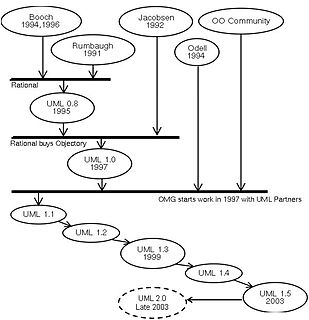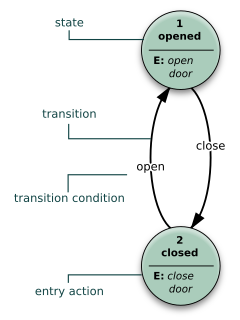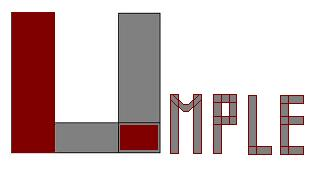
An object-modeling language is a standardized set of symbols used to model a software system using an object-oriented framework. The symbols can be either informal or formal ranging from predefined graphical templates to formal object models defined by grammars and specifications.
Prototype-based programming is a style of object-oriented programming in which behaviour reuse is performed via a process of reusing existing objects via delegation that serve as prototypes. This model can also be known as prototypal, prototype-oriented,classless, or instance-based programming. Delegation is the language feature that supports prototype-based programming.

A data model is an abstract model that organizes elements of data and standardizes how they relate to one another and to properties of the real world entities. For instance, a data model may specify that the data element representing a car be composed of a number of other elements which, in turn, represent the color and size of the car and define its owner.
In object-oriented programming, a metaclass is a class whose instances are classes. Just as an ordinary class defines the behavior of certain objects, a metaclass defines the behavior of certain classes and their instances. Not all object-oriented programming languages support metaclasses. Among those that do, the extent to which metaclasses can override any given aspect of class behavior varies. Metaclasses can be implemented by having classes be first-class citizen, in which case a metaclass is simply an object that constructs classes. Each language has its own metaobject protocol, a set of rules that govern how objects, classes, and metaclasses interact.

An entity–relationship model describes interrelated things of interest in a specific domain of knowledge. A basic ER model is composed of entity types and specifies relationships that can exist between entities.
A stereotype is one of three types of extensibility mechanisms in the Unified Modeling Language (UML), the other two being tags and constraints. They allow designers to extend the vocabulary of UML in order to create new model elements, derived from existing ones, but that have specific properties that are suitable for a particular domain or otherwise specialized usage. The nomenclature is derived from the original meaning of stereotype, used in printing. For example, when modeling a network you might need to have symbols for representing routers and hubs. By using stereotyped nodes you can make these things appear as primitive building blocks.

Object Process Methodology (OPM) is a conceptual modeling language and methodology for capturing knowledge and designing systems, specified as ISO/PAS 19450. Based on a minimal universal ontology of stateful objects and processes that transform them, OPM can be used to formally specify the function, structure, and behavior of artificial and natural systems in a large variety of domains.

A sequence diagram shows object interactions arranged in time sequence. It depicts the objects and classes involved in the scenario and the sequence of messages exchanged between the objects needed to carry out the functionality of the scenario. Sequence diagrams are typically associated with use case realizations in the Logical View of the system under development. Sequence diagrams are sometimes called event diagrams or event scenarios.
UML color standards are a set of four colors associated with Unified Modeling Language (UML) diagrams. The coloring system indicates which of several archetypes apply to the UML object. UML typically identifies a stereotype with a bracketed comment for each object identifying whether it is a class, interface, etc.
This glossary of Unified Modeling Language terms covers all versions of UML. Individual entries will point out any distinctions that exist between versions.
Executable UML is both a software development method and a highly abstract software language. It was described for the first time in 2002 in the book "Executable UML: A Foundation for Model-Driven Architecture". The language "combines a subset of the UML graphical notation with executable semantics and timing rules." The Executable UML method is the successor to the Shlaer–Mellor method.
Object-oriented design is the process of planning a system of interacting objects for the purpose of solving a software problem. It is one approach to software design.
Composite structure diagram in the Unified Modeling Language (UML) is a type of static structure diagram, that shows the internal structure of a class and the collaborations that this structure makes possible.
ECO , is a software framework suited for Domain-Driven-Design (DDD) from Capable Objects AB, designed to increase productivity by utilizing facilities such as Object-relational mapping (ORM) for persisting domain objects, UML models for domain classes and executable State Machines for behavior control defined in UML notation. The ECO framework is intended to be an all-in-one solution for enterprise development and includes in-memory transactions and Undo/Redo functionality as well as easy binding with UI layer. ECO unites ORM framework and UML modeling tools with instant code generation and an OCL expression evaluator for simplified in-memory and DB queries, business rules and other useful facilities.
UML state machine, also known as UML statechart, is a significantly enhanced realization of the mathematical concept of a finite automaton in computer science applications as expressed in the Unified Modeling Language (UML) notation.

UML is a modeling language used by software developers. UML can be used to develop diagrams and provide users with ready-to-use, expressive modeling examples. Some UML tools generate program language code from UML. UML can be used for modeling a system independent of a platform language. UML is a graphical language for visualizing, specifying, constructing, and documenting information about software-intensive systems. UML gives a standard way to write a system model, covering conceptual ideas. With an understanding of modeling, the use and application of UML can make the software development process more efficient.

Umple is a language for both object-oriented programming and modelling with class diagrams and state diagrams. The name Umple is a portmanteau of "UML", "ample" and "Simple", indicating that it is designed to provide ample features to extend programming languages with UML capabilities.














